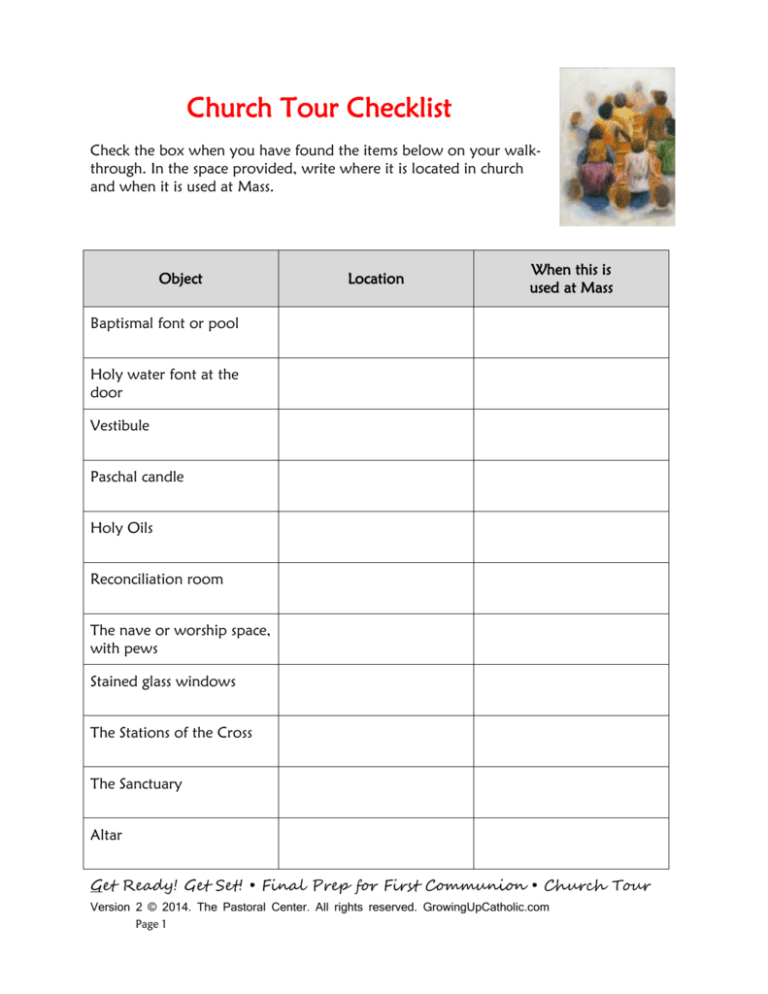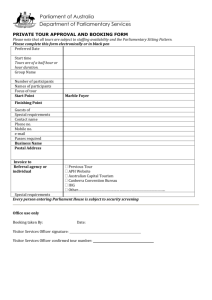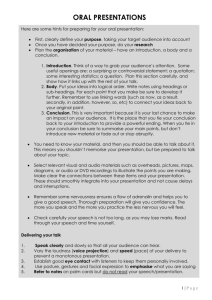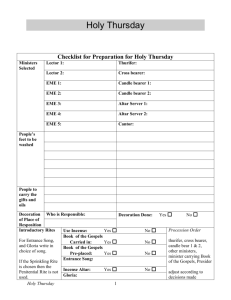
Church Tour Checklist
Check the box when you have found the items below on your walkthrough. In the space provided, write where it is located in church
and when it is used at Mass.
Object
Location
When this is
used at Mass
Baptismal font or pool
Holy water font at the
door
Vestibule
Paschal candle
Holy Oils
Reconciliation room
The nave or worship space,
with pews
Stained glass windows
The Stations of the Cross
The Sanctuary
Altar
Get Ready! Get Set! • Final Prep for First Communion • Church Tour
Version 2 © 2014. The Pastoral Center. All rights reserved. GrowingUpCatholic.com
Page 1
Ambo (Lectern)
Chair (Priest’s or Presider’s)
Tabernacle and candle
Roman Missal
Lectionary
Chalice and paten
Vestments
Processional Cross
Statues of Mary and the
Saints, or the life of Christ
What else did you learn
about?
Get Ready! Get Set! • Final Prep for First Communion • Church Tour
Version 2 © 2014. The Pastoral Center. All rights reserved. GrowingUpCatholic.com
Page 2
We gather for Eucharist │ Mark Hakomaki
Get Ready! Get Set! • Final Prep for First Communion • Church Tour
Version 2 © 2014. The Pastoral Center. All rights reserved. GrowingUpCatholic.com
Page 3
Tour Guide to the Catholic Church
Note: This church tour should be entered into with great reverence. Begin by telling
everyone that we Catholics consider our churches to be sacred space. As we enter, we
dip our hand into holy water and make the Sign of the Cross. Be sure everyone does this
as you enter. We also genuflect to the tabernacle as we enter, to show our reverence. Do
this, and be sure all present follow suit. Each time you cross the center aisle, bow
reverently toward the sanctuary, and teach your group to do the same.
Not all churches look alike! Just as family homes differ from one to the next, so parish
churches also reflect the personality and history of the parish. Use these notes for your
tour, but adapt them to your own parish setting. You have permission to cut, paste, and
shape these as you need to.
The baptismal pool or font. Usually at or near the main entrance of the church. Reminds
us that every time we come to Eucharist we enter once again the waters of baptism.
Baptism is our way of entering the Church. In some churches, the baptismal font stands in
the front, near the altar.
When we come into church, we dip our hand in the holy water font (or baptismal font if
it’s handy), and make the Sign of the Cross. We trace on our bodies the sign of our faith,
and our agreement at baptism to die to ourselves as we sacrifice ourselves in love for
each other.
The paschal candle usually stands near the baptismal font. On Holy Saturday night,
which we call the Easter Vigil, this candle was blessed by us and now stands as a sign of
the Light of Christ. During that prayer, the priest uses these words: "May all who are
buried with Christ in the death of baptism rise also with him to newness of life."
We call the entry area of the church the narthex or vestibule.
Also near the baptismal font, there is a small cabinet in which we keep the Holy Oils.
This is called the ambry. There are three vessels of oil: the oil of catechumens, which is
used to bless those preparing for baptism; the oil of the sick, with which the priest brings
Jesus' strength to those who are in serious illness; and the sacred chrism, which is used in
celebrating the sacraments of baptism, confirmation, and holy orders.
Somewhere near the back or side of the church is the reconciliation room, a small chapellike room designed for the celebration of the sacrament of reconciliation. There may also
be one or more confessionals. These are small cubicles in which we celebrated the
sacrament of reconciliation prior to Vatican II.
The large gathering area of the church, where all the people sit for Mass, is called the
nave. This big room is usually filled with pews.
Get Ready! Get Set! • Final Prep for First Communion • Church Tour
Version 2 © 2014. The Pastoral Center. All rights reserved. GrowingUpCatholic.com
Page 4
Hanging around the outside walls of the church are the 14 carvings or small images which
represent the Way of the Cross. This is a series of images which recount the passion story
of Jesus, his “way to the Cross.”
The center of the church, without doubt, is the sanctuary. All eyes are drawn to it.
Standing in an obvious place is the presider's chair, which is usually accompanied by
seating for the other ministers. This seating is arranged so that the presider and other
ministers are actually part of the assembly, yet able to perform their proper roles.
There is also here the place from which the readings are proclaimed, called the ambo,
and the place from which the Gospel is proclaimed and the homily is preached, usually
called the pulpit or lectern. It’s here that we put the lectionary, the book of readings
from Sacred Scripture.
The center of all this is the table or the altar. This is where we celebrate Mass. When we
celebrate the Eucharist, we cover the table with an altar cloth. We place the bread and
wine for Mass here. The bread is on a bread plate or paten, and the wine is poured into
a chalice.
We also always have a crucifix in this area of the church. It’s usually carried in during the
opening of the Mass, along with candles, which represent the light of Christ. Located
near the altar, but not on it, is the tabernacle. This is where the Blessed Sacrament is kept.
Next to the tabernacle is a candle which is kept burning at all times, and this is called the
sanctuary lamp.
In some churches, there is a small chapel nearby in which the tabernacle is kept. This
chapel may be used for daily Mass or quiet personal prayer. People make visits to pray in
front of the Blessed Sacrament.
In many churches, there are images of Mary and the Saints, or depictions from the life of
Christ, either in stained glass, painting, frescoes, or statues. Some Catholics light a votive
candle in front of a statue or shrine as a reminder that their prayers continue even after
they leave the church.
If it is an older church, there is a rather elaborate “high altar” against the back wall of the
sanctuary. This is called a reredos.
The priest and deacons, and some of the other ministers, wear special clothing when
celebrating the liturgy and the sacraments. These are called vestments. Under the colorful
outer garment at Mass, the priest wears a long white garment, which is called an alb. The
colorful outer garment is called a chasuble. The priest also wears a stole, a long piece of
cloth about four inches wide draped around the neck.
Get Ready! Get Set! • Final Prep for First Communion • Church Tour
Version 2 © 2014. The Pastoral Center. All rights reserved. GrowingUpCatholic.com
Page 5










